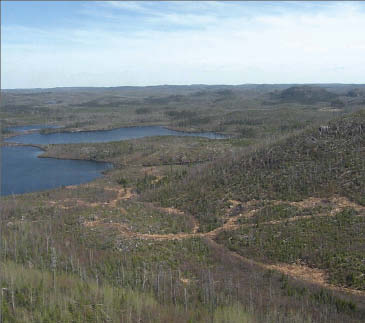The economic viability of Argex Mining‘s (RGX-V) La Blache titanium dioxide project in Quebec has now received validation with the results of a preliminary economic assessment (PEA), the company says.
The La Blache deposit, about 120 km northwest of the city of Baie-Comeau on the north shore of the St. Lawrence River, has a National Instrument 43-101 compliant resource of 30.9 million tonnes grading 18.78% titanium dioxide (TiO2), 63.29% iron oxide (Fe2O3) and 0.45% vanadium pentoxide (V2O5) in the measured and indicated categories. Inferred resources add 2.9 million tonnes of 18.67% TiO2, 63.06% Fe2O3 and 0.43% V2O5.
According to the PEA, Argex’s 100%-owned project will have a 32% pre-tax internal rate of return and a net present value of $2.2 billion at an 8% discount rate. The life-of-mine has been estimated at 25 years with payback in seven years. Capital costs come in at $801 million and total operating costs net of by-product credits would average $586 per tonne of TiO2 over the mine’s life. The model was based on an initial production profile of 15,000 tonnes of TiO2 a year, and will be later scaled up to 195,000 tonnes a year.
The PEA used a three-year trailing average for TiO2 of US$2,846 per tonne. Today titanium dioxide is selling for between US$3,400 and US$4,000 per tonne, says Mark Billings, the company’s co-founder and chief financial officer. “The price should reach US$6,000 per tonne by the time we go into production.”
The Montreal-based junior has proprietary technology that enables it to produce high-purity TiO2 directly from run-of-mine material. The process has been running continuously since February at a mini-plant in Mississauga, Ont. “The titanium dioxide pigment produced has achieved brightness results that are in-line with or superior to some of the major titanium dioxide industry producers,” the company noted in a press release.
Enrico Di Cesare, the company’s chief operating officer and vice-president of technology, says the study “confirms the technological and economic viability of Argex’s proprietary metallurgical process and clears the path towards the next step – the construction of an industrial-sized pilot plant.” He adds that because “a typical PEA is based on laboratory-scale metallurgical testing, our study has gone well beyond what is normally expected . . . [and] this should permit us to fast track our feasibility-stage studies.”
Co-founder Billings said in an interview from Montreal that the chemical process, invented by metallurgists from India who came to Canada in the 1970s, involves placing the ore in vats of hydrochloric acid at room pressure and temperature, and precipitating titanium out of the slag. Afterwards the hydrochloric acid is recycled and reused. “We spent a lot of time and money on the process, and lo and behold, the tests all came back positive,” he says. “No one else to our knowledge has been able to do this . . . a lot of people told us it was impossible.”
Argex bought the properties in 2009, raised $5 million and drilled 20,000 metres to validate the historic resource. They published a resource estimate earlier this year in May. Billings says the company will conduct more studies and undertake a feasibility study. Argex could be shipping TiO2 by the end of 2013, or early 2014.
Billings notes that titanium dioxide is popular in paint, but it also has a number of other uses, including welding and titanium metals for civil and military aviation. “There’s a big demand from aircraft companies for more titanium metal,” he says. “And we could use our titanium dioxide as feedstock to produce titanium metal.”
The La Blache property covers three titaniferous, magnetite lenses named Hervieux West, Hervieux East and Lac Schmoo. The magnetite lenses are hosted in intrusive lithologies of the La Blache anorthosite complex and are aligned over a distance of 6 km. The individual lenses are between 100 metres and 1,150 metres in strike length, with thickness ranging from 45 metres to 215 metres. According to Met-Chem Canada, the drill holes completed by Argex indicate that the Hervieux East and West deposits are in large part open at depth.
At presstime Argex traded at 43¢ per share within a 52-week range of 30¢-92¢. The junior has 92.14 million shares, fully diluted.


Be the first to comment on "Argex completes PEA on titanium dioxide project"